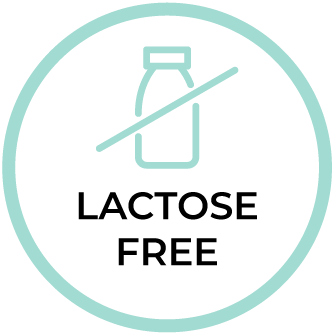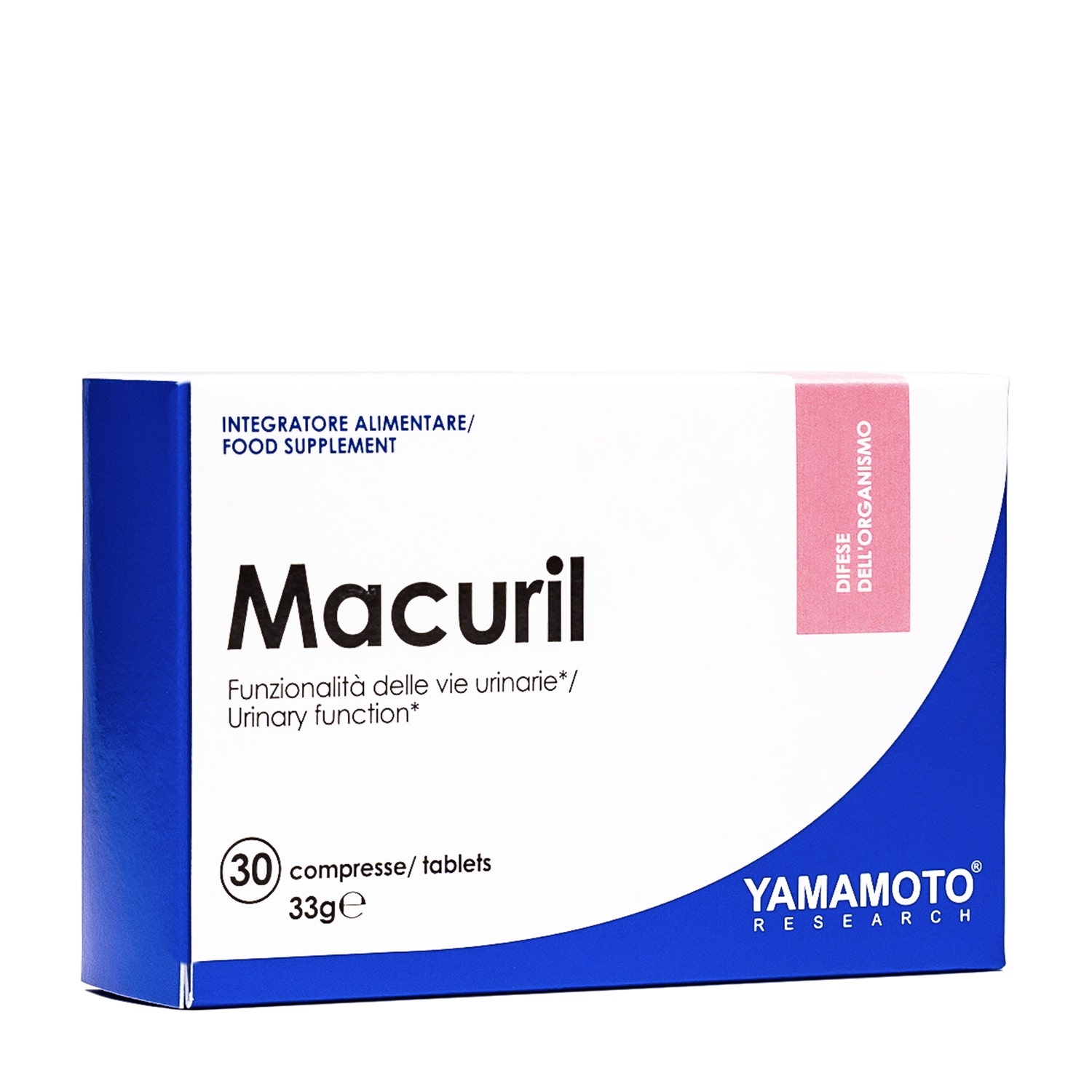- Home
- Macuril
Macuril
30 CapletsThe functional ally for your urinary tract health
- Based on D-Mannose and Cranberry extract
- Supports urinary tract function
- Supports drainage of body fluids
- Protective action against recurrent bacterial infections


According to statistics, about one in two women has had the experience of at least one annoying episode of cystitis during the course of their life. However, urinary tract infections do not affect only women; also men, although to a significantly lesser extent, may suffer from those symptoms which can become particularly debilitating.
In particular, the typical symptoms of urinary tract inflammation are:
-
Increased frequency of the need to urinate during the day, with a reduction, however, of the volume of urine expelled;
- Need for an excessive effort to urinate that may stop abruptly;
- Strong burning sensation during urination;
- Painful and debilitating spasms followed by the urgent need to urinate during the course of the day;
- Turbid and sometimes also malodorous urine;
- In very severe cases, the presence of pus and blood in the urine.
There are several causes or factors that can favour the onset of urinary tract infections, such as: stress factors, antibiotic therapy or irregular diet, states of severe physical and mental fatigue, poor or excessive intimate hygiene, or that in any case does not respect the physiological pH of the interested part, or alterations of the intestinal bacterial flora. Women then have to take into account the use of internal absorbents which favour infections and the use of some contraceptives that alter the pH of the genital apparatus, such as spermicidal creams or the diaphragm, wearing tight-fitting underwear and diabetes, because the glucose in urine can in fact encourage bacterial growth.
Cystitis is an inflammation of the bladder, due to bacterial infection, and is the most frequent type of lower urinary tract infection, followed by urethritis, urosepsis and other particular forms such as prostatitis.
In most cases, the incriminated bacterium is Escherichia coli, which is present in the intestine for the production of faeces, which can return through the urethra into the bladder, or proliferate internally from the intestine to the bladder, especially in the event of constipation.
Unlike prostatitis, which for obvious reasons is a male urinary infection, both cystitis and urethritis can affect both genders, although cystitis is more prevalent among women and urethritis among men. Urethritis can also be a consequence of trauma due to catheters or kidney stones.
Cystitis in fact affects women more due to the anatomical peculiarities of the female genital system, closer to the anal region and with a shorter urethra, as well as due to the use of mechanical contraceptives (diaphragm, spiral) and spermicidal creams that weaken the natural defences against germs. Unlike men, women are more prone to infections of the genital-urinary system at a young age, during the fertile period.
In some predisposed individuals, inflammation of the urinary tract can become recurrent and even return several times in a year, becoming a real nightmare for many women, since the symptoms of urinary tract infections are particularly disabling and in their acute phase they make it very difficult to lead a normal social and work life, sometimes even causing fever. A medical consultation is very often required in the most severe cases. It is therefore very important, from the earliest signs, to look after oneself with great care and scrupulously follow certain behaviour. More and more confirmations have come from the world of nutraceuticals; in fact, it is well established practice by the medical class to recommend nutraceutical supplements based on cranberry and D-mannose for prevention or as adjuvants to therapy, which prevent bacteria from taking root on the walls of the bladder. The most effective has turned out to be cranberry, the action of which focuses specifically on intestinal bacteria such as the most "incriminated" Escherichia coli. Intake of this effective combination is then prolonged for a few days after antibiotic therapy for a more effective "cleansing" and prevention of recurrence.
The combined action of cranberry and D-mannose is aimed at neutralising the "fimbriae" of the Escherichia coli bacterium: the fimbriae are like "harpoons" that the bacterium uses to adhere to the cells of the human organ (in this case the bladder) and infect it. There is a protein called adhesin at the ends of the bacterial fimbriae which acts as a coupling element between the bacterium and the host cells.
Cranberry is rich in organic acids (including salicylic acid), fructose and antioxidants such as vitamin C, flavonoids, catechins, triterpenoids and anthocyanins (produced by the plant to defend itself from attack by microorganisms).
The American cranberry is a shrub that produces a fruit with healing qualities already appreciated by the Native American populations, who mixed the fruits with dried meat to prepare "pemmican", a precious tonic for facing the winter. The Swedes use the juice to accompany desserts. In our modern age, it has long been used for its action against inflammations of soft tissues and recurrent urinary infections, such as cystitis, which can be caused largely by bacterial infections from Escherichia coli and sometimes extend to the urethra, causing really intense burning and pain in the pubis. The cranberry contains various valuable and beneficial substances that prevent recurrences: type A proanthocyanins, in particular, inhibit the adhesion of bacteria to the epithelial surfaces and mucosa; the presence of flavonoids, tannins and vitamin C play an anti-inflammatory function and promote diuresis. Finally, malic and citric acids also have a highly purifying effect on urine.
The strong point of cranberry extract is that it counteracts colonisation of the urinary tract by bacteria. Anthocyanins, in fact, interfere with the adhesion of E. coli to the walls of cells that line the urinary tract, effectively preventing it from rising to the bladder, and by countering the adhesive power of P-type fimbriae, the bacterium will no longer be able to take root and will be expelled through urine. The cranberry is rich in proanthocyanidins, molecules able to bind to the adhesins of E. coli, exerting an anti-adhesive action on them.
D-mannose is increasingly widespread in food supplement-based treatments of cystitis, and the synergy of action with cranberry, as found in Macuril, makes it one of the natural remedies of choice as a preventive activity, adjuvant to acute and maintenance phases. D-mannose is a dextrorotatory sugar that is not metabolised, does not interfere with blood glucose levels and also does not alter intestinal microflora. The mechanism of action underlying its anti-infective activity is represented by the competitive inhibition of bacterial adhesion, in particular of E. coli, to the urothelial cells.
Backed by clinical literature that demonstrates its effectiveness, it is extremely useful in the treatment of cystitis caused by E. coli, due to a mechanism of interference with its engraftment to the walls of the urinary tract, or thanks to the high affinity that D-mannose also presents through the adhesins located on the tip of the type 1 enteric fimbriae. And because D-mannose has a structure very similar to the binding site of cellular glycoprotein receptors, it acts as a competitive inhibitor of bacterial adhesion. The high affinity of D-mannose for E. coli adhesins in vivo has also been demonstrated against many other bacteria with fimbriae such as Pseudomonas aeruginosa in vitro. As a consequence, the use of D-mannose represents an effective weapon for the medical class in the urogynaecolocical field for acting both as a prophylaxis and as an adjuvant treatment for urinary tract infections, because it counteracts E. coli implantation on the receptors of bladder and vaginal epithelium cells, then facilitating the detachment and subsequent elimination of E. coli with urinary flow. Having no side effect, use of Macuril can be extended to several weeks from the event as preventive therapy against recurrences, and it contributes to the restructuring of damaged mucous membranes, thus offering greater protection from subsequent bacterial insults.
| Mean analysis | ||
| Per daily dose (2 tablets) | ||
|
| Per daily dose (2 tablets) | |
| D-mannose | 1000 mg | |
| Cranberry d.e. | 400 mg 40 mg | |
|
| | |


D-mannose, bulking agent: microcrystalline cellulose; cranberry (Vaccinium macrocarpon Aiton) fruit e.g. tit. 10% proanthocyanidins; glazing agents: hydroxy-propyl methylcellulose, polyethylene glycol; anti-caking agents: magnesium salts of fatty acids, silicon dioxide.


